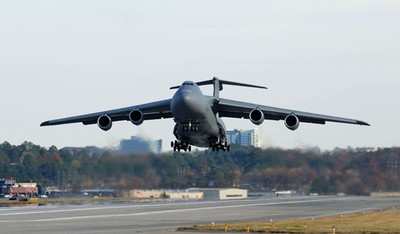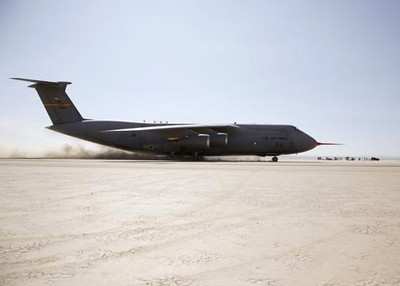Modernized Transport Joins Test Fleet
The skies are now just a little smaller... as the second
modernized Lockheed Martin C-5M Super Galaxy test aircraft made its
first flight November 17 from Georgia's Dobbins Air Reserve Base.
This is the second of three aircraft that will comprise the new
C-5M test fleet.

"The C-5M represents a true recapitalization program for a
critical capability, ensuring a viable strategic airlift resource
for America through the year 2040," said George Shultz, vice
president, Lockheed Martin C-5 Modernization program.
"Modernized C-5 Galaxy aircraft will improve the fleet aircraft
availability and the overall reliability and maintainability, while
reducing total ownership costs," Shultz said. "The C-5M provides
the U.S. Air Force and American taxpayer with a significant return
on their investment."
"We're excited about the C-5M," said Col. Devin Cate, 716th
Aeronautical Systems Group commander at Ohio's Wright Patterson
AFB. "Who wouldn't be excited about being on a new aircraft
program? People can say it's an old airplane, but the C-5M is a new
version. It has so much more capability than the current
fleet."
The C-5M includes avionics modernization, along with reliability
enhancement and re-engining. The Avionics Modernization Program
adds a new, modern cockpit that includes a digital all-weather
flight control system and autopilot, a new communications suite,
flat panel displays, and enhanced navigation and safety equipment
to ease crew workload and enhance situational awareness.
C-5 aircraft which have completed the AMP process have logged
more than 4,000 hours with the new system, many of which were flown
in support of Operation Iraqi Freedom.
The centerpiece of the Reliability Enhancement and Re-engining
Program is the General Electric CF6-80C2 commercial engine, which
has more than 288 million flight hours on more than 229 commercial
and military customers, including the VC-25s (Air Force One) used
by the president of the United States. This engine delivers a 22
percent increase in thrust to the C-5M, a 30 percent shorter
take-off roll, has a 58 percent faster climb rate and will allow
significantly more cargo to be carried over longer distances.
As Aero-News reported, the
first test aircraft first flew June 19. To date, it has logged more
than 51 flight hours, and it completed dynamic taxi testing at the
Air Force Flight Test Center at Edwards Air Force Base in August
(below).

This latest aircraft will be used mostly for utilities and
subsystem tests, airfield performance, and diagnostics testing.
Both of these aircraft were originally C-5B models.
A third test aircraft to be brought up to C-5M standards, a
C-5A, is currently in the final stages of modernization and
scheduled to fly later this year.
With more than 2 million flight hours since entering the fleet
in 1970, the C-5 has been the backbone of strategic airlift in
every military engagement from Vietnam through Operation Iraqi
Freedom. It is the only aircraft capable of carrying 100 percent of
certified air-transportable cargo and includes a dedicated
passenger compartment enabling commanders to have troops and their
equipment arrive in an area of operation simultaneously.
 ANN's Daily Aero-Linx (05.02.24)
ANN's Daily Aero-Linx (05.02.24) ANN's Daily Aero-Term (05.02.24): Touchdown Zone Lighting
ANN's Daily Aero-Term (05.02.24): Touchdown Zone Lighting Aero-News: Quote of the Day (05.02.24)
Aero-News: Quote of the Day (05.02.24) ANN FAQ: Contributing To Aero-TV
ANN FAQ: Contributing To Aero-TV NTSB Final Report: Cirrus Design Corp SR20
NTSB Final Report: Cirrus Design Corp SR20




